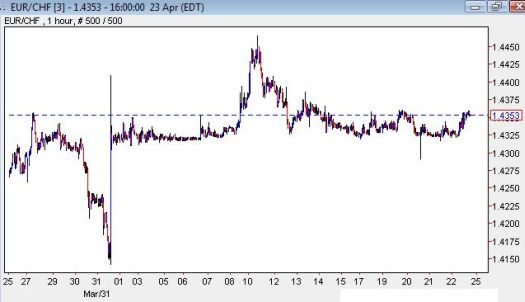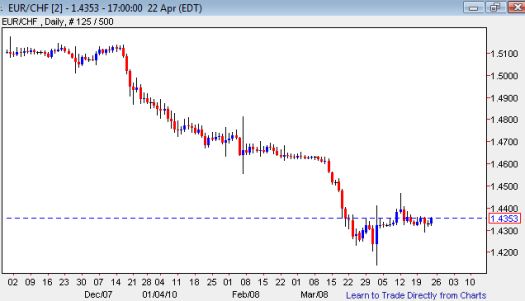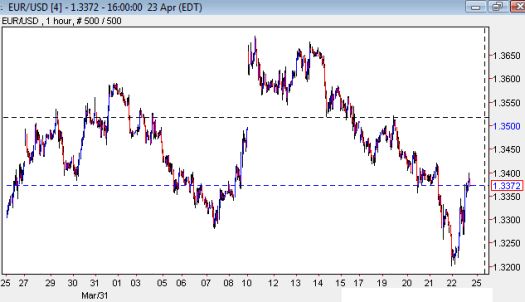On April 1, 2010, the Swiss National Bank (SNB) apparently intervened to arrest the appreciation of its currency against the euro, and I wondered whether this action would be as futile as all the other interventions this year. So far, so good for the SNB, as the previously persistent buyers of Swiss francs have all but disappeared this month. The SNB’s massive holiday surprise seems to have tamed them for now. The hourly chart below shows the remarkable stability in the current floor for EUR/CHF (around 1.43):

The recent stability in EUR/CHF is even more remarkable after reviewing the daily action since December. It almost appears the downtrend has finally come to a halt with April exhibiting a rare and subtle upward bias relative to previous months.

I am assuming that the SNB intervened on the days with exceptionally large ranges. Implicit confirmation of massive currency intervention came from the SNB’s “Monthly Statistical Bulletin April 2010.” This bulletin includes “Foreign currency investments of the SNB by currency.” This report shows the SNB increased the value of its euro holdings by a massive 52% from the fourth quarter of 2009 to the first quarter of 2010. The SNB implemented a similar increase in euro holdings in the second quarter of 2009. The SNB must be frustrated, or at least disappointed, that the franc still hit multi-decade highs against the euro despite all this intervention.
The report on foreign currency investments also shows a large increase in holdings of Japanese yen. The SNB has grown its yen reserves as fast as its euro reserves. The annual correlation of euro to yen is 0.63 from 2005-2009, but the quarterly correlation since 2008 is 0.85. I have no explanation or speculation for this parallel build-up, but I am curious!
The relative stability in EUR/CHF has come during a month in which the euro has swung wildly (against the U.S. dollar). Note well how the steep decline in the euro over the past week did not cause a parallel plunge in EUR/CHF.

Source: all charts from dailyfx.com
This action makes me now wonder whether the SNB has figured out how to maintain an on-going intervention! If so, the SNB probably has a steep uphill battle ahead. For example, a Deutsche Bank analyst expects SNB interventions to prove futile once again on the way to a 1.375-1.40 bottom for EUR/CHF. Now that the SNB has tightened liquidity requirements for its big banks, the franc may look even more attractive to traders and investors versus the euro.
Since the last intervention, I lightened up on my long EUR/CHF position. (The odd dip on Wednesday – see chart above – stopped me out of the remaining position, but I quickly re-established the long in anticipation of a headfake). I dumped the short GBP/CHF hedge as it failed this time around with the franc weakening alongside the euro. The long USD/CHF positions performed best of all. If (when?) the buyers of francs return, I will switch my trading bias accordingly.
Be careful out there!
Full disclosure: long EUR/CHF, USD/CHF, and GBP/CHF
